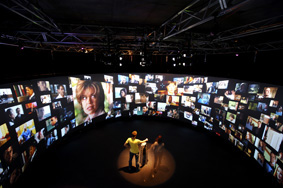

T_Visionarium (2008)
Neil Brown, Dennis Del Favero, Matt McGinity, Jeffrey Shaw,
Peter Weibel © UNSW iCinema Centre
Two hundred and fifty video clips are simultaneously displayed and distributed around AVIE's circular screen. Using a special interface the viewer can select, re-arrange and link these video clips at will, composing them into combinations based on relations of gesture and movement. By these means the experience of viewing the television screen is not so much superseded as reformatted, magnified, proliferated and intensified. It is the experience of this new kind of spatial connectivity that gives rise to a revolutionary way of seeing and reconceptualising TV in its aesthetic, physical and semantic dimensions. To use the T_Visionarium apparatus is not to view a screen or even multiple screens, but to experience a space within which screen imagery is dynamically re-formulated and re-imagined. Here, media is not an object of study but a material landscape in which we are component parts. Stripped of its conventional narrative context, the aesthetic, behavioural and media qualities of television become strikingly apparent, and by affording us an active involvement T_Visionarium hones both our awareness of and our dexterity with this media. In essence, it is not so much a tool that delivers control of a mediascape but a mode of inhabiting televisual imagery: a sphere of pure and endless mediality.
(Adapted from Jill Bennett, T_Visionarium: A User's Guide, ZKM/UNSW Press, Karlsruhe/Sydney: 2008)
Project Directors: Neil Brown, Dennis Del Favero, Matthew McGinity, Jeffrey Shaw, Peter Weibel
Lead Software Engineer: Matthew McGinity
Distributed Video Engine: Balint Seeber
Application Software: Jared Berghold, Ardrian Hardjono, Gunawan Herman, Tim Kreger, Thi Thanh Nga Nguyen, Multimedia and Video Communication Research Group (Dr Jack Yu) NICTA
Co-Ordination and Interaction Design: Dennis Del Favero, Volker Kuchelmeister, Matthew McGinity, Jeffrey Shaw
Management: Damian Leonard, Sue Midgley
Assistants: David McKenzie, Caitlin Fraser, Gabriel Nervo
This project was supported under the Australian Research Council's Discovery funding scheme (DP0345547)
